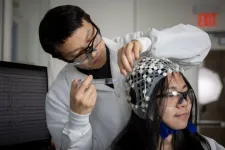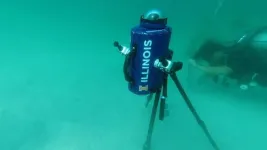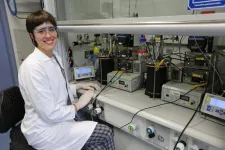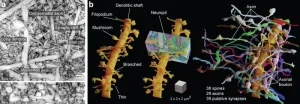(Press-News.org) The study of biomarkers in the brain—powered by cutting-edge machine learning techniques—could redefine the way mental health conditions are categorized and diagnosed and lead to more effective, personalized treatments.
That’s the goal of Yu Zhang, an assistant professor of bioengineering and electrical and computer engineering in Lehigh University’s P.C. Rossin College of Engineering and Applied Science who recently landed major support from the National Institute of Mental Health (NIMH), a division of the National Institutes of Health (NIH). The two grants, which total nearly $4 million, will fund two projects searching for biomarkers using brain imaging and machine learning (ML) to improve diagnosis and treatment outcomes for patients with mental health disorders.
A biomarker is essentially a sign of some type that indicates a medical state and can be measured.
The first study aims to improve the treatment of depression. Approximately 280 million people around the world have the condition, according to the World Health Organization. Antidepressants are the primary form of treatment, but they are effective in only about half of patients who take them, says Zhang, who leads the Brain Imaging and Computation Laboratory (BIC Lab) at Lehigh.
“Traditionally, medical professionals use a combination of behavioral and clinical symptoms to diagnose depression, and those symptoms are fairly subjective and cause substantial heterogeneity in the patients,” he says. “Our goal is to build objective biomarkers using brain imaging and machine learning that better capture the brain’s dysfunction. Those biomarkers will essentially enable us to predict whether an individual patient will respond to medication based on their brain circuits, and that will help guide personalized intervention.”
Zhang and his team, which includes collaborators from Dell Medical School (Dell Med) at the University of Texas at Austin, the Perelman School of Medicine (PSOM) at the University of Pennsylvania, and Stanford University School of Medicine, will utilize data from a double-blind randomized placebo-controlled clinical trial for the biomarker establishment. Those data, including functional magnetic resonance imaging (fMRI) and electroencephalography (EEG) collected from patients prior to treatment, will be used to train a machine-learning model to identify biomarkers in the brain.
“Instead of single brain regions, the biomarker we are looking for is characterized by the interaction between different regions and between brain imaging modalities,” says Zhang. “We’re looking at large-scale brain networks related to a variety of psychiatric disorders, mainly involving cognitive working memory and emotional regulation. We hypothesize that the interaction between these intrinsic brain networks might reveal informative biomarkers that can predict individual-level treatment response.”
Essentially, he says, the degree of interaction between the networks may indicate the degree by which a person would respond to medication.
Once the team builds the model, they’ll test it by conducting an independent clinical trial. Investigators at Dell Med will recruit approximately 50 people diagnosed with depression, prescribe them antidepressant medication, and measure the change in their symptoms.
“And we’ll be collecting pretreatment brain imaging data and using that data to verify and optimize our biomarker findings,” says Zhang.
He envisions a future where the model—which would be easily installed on any computer—works in tandem with a portable EEG device.
A clinic or hospital patient would have their brain scanned by the EEG, and that data would be fed into the model. The model would use those brain signals to assess the strength or weakness of the connections between regions of the brain—i.e., the biomarkers—and then generate output that tells the doctor or clinician how well, or not, the person would likely respond to antidepressant medication based on those biomarkers.
While Zhang and his team are looking only at selective serotonin reuptake inhibitors, or SSRIs, the ultimate goal, he says, is to fine-tune the model enough that it can predict a person’s response to other compounds.
Their AI-guided biomarker would not only deliver a personalized approach to treatment, he says, but also replace the current trial-and-error treatment strategy that wastes both time and money.
“Often, for patients, time is even more important than money,” says Zhang. “So combining cutting-edge artificial intelligence with brain imaging could really drive a novel treatment solution that helps people quickly, and gives them greater confidence about their treatment. This could be a form of precision mental-health care that could offer patients real hope.”
Zhang’s second newly funded study will also use brain imaging data to identify biomarkers, this time to redefine the classification of mental disorders.
Currently, mental health conditions are grouped according to subjective behavioral and clinical assessments and self-reported questionnaires, says Zhang. The result is that within a single diagnostic category such as autism, the range of symptoms can be vast.
“Some patients show very different—or heterogenous—symptoms compared with other patients within that autism category,” he says. “At the same time, across categories like autism, attention-deficit/hyperactivity disorder, and depression, you’ll find there’s considerable overlap, or comorbidity, in symptoms. We believe there is a lack of in-depth understanding of the heterogeneity and comorbidity in major psychiatric disorders. Our project will collect more objective measures from the human body. We’ll combine brain imaging data with machine learning to identify neurocircuit abnormalities across traditional diagnoses that will help us redefine the classification of mental disorders.”
Redefining the classification system could facilitate the development of more effective treatment for patients, says Zhang. Right now, patients diagnosed with a specific disorder are generally treated with a one-size-fits-all approach. Some patients will respond well, but others won’t respond at all, and still others may experience adverse reactions. And that’s because of the wide variation in how their brains work. If the system could be more fine-tuned, treatments such as medication, psychotherapy, and neuromodulation therapy could be better dialed toward specific needs.
Zhang and his team will feed brain imaging and behavioral assessment data into a machine learning model that will identify brain connectivity patterns. Those biomarkers will help explain mental health conditions along more of a continuum.
“Right now, a diagnosis is like a hard label, but we think that explaining these conditions along a spectrum will help us identify subpopulations within a clinical sample,” he says. “Once we identify these subtypes, we can further study their unique and shared brain abnormalities, and better understand what treatment will be most useful for that specific subtype.”
The idea is that eventually doctors would initially collect both brain imaging and behavioral data from a patient, feed it into the model to learn in which subtype the patient belongs, and then proceed with the treatment suited to that subtype.
“This work has the potential to redefine mental health conditions, and would be a major breakthrough in the field,” says Zhang. “It could help us establish more effective therapeutics for individual patients, which is something traditional clinical diagnoses can’t achieve.”
Research reported in this story is supported by the National Institute of Mental Health of the National Institutes of Health under award numbers R01MH129694 and R21MH130956.
Related Links
Rossin College Faculty Profile: Yu Zhang
Lehigh University: Brain Imaging and Computation Laboratory (BIC Lab)
NIH RePorter: Establishing Multimodal Brain Biomarkers Using Data-driven Analyticsfor Treatment Selection in Depression
NIH RePorter: Identifying Transdiagnostic Functional Connectivity Biomarkers for Cognitive Health and Psychopathology
Lehigh University: Institute for Data, Intelligent Systems, and Computation (I-DISC) END
Biomarkers may hold key to precision mental health diagnosis, care
NIH grants totaling nearly $4 million support Lehigh Engineering professor’s AI-driven approach that could revolutionize the way conditions such as depression are classified, diagnosed, and treated
2023-07-10
ELSE PRESS RELEASES FROM THIS DATE:
Navigating the future of underwater geolocalization: how polarization patterns enable new technology
2023-07-10
University of Illinois Urbana-Champaign researchers have developed a novel method for underwater geolocalization using deep neural networks that have been trained on 10 million polarization-sensitive images collected from locations around the world. This new study, led by electrical and computer engineering professor Viktor Gruev, along with computer science professor David Forsyth, enables underwater geolocalization using only optical data while providing a tool for tethered-free underwater navigation.
These findings were recently published in the journal eLight.
“We are showing for the first time, you can geolocate yourself, or a camera, in a number of different ...
Anastasopoulos receives funding for EAGER: building language technologies by machine reading grammars
2023-07-10
Antonios Anastasopoulos, Assistant Professor Computer Science, received $99,294 from the National Science Foundation for: "EAGER: Building Language Technologies by Machine Reading Grammars." This funding began in June 2023 and will end in late May 2024.
Anastasopoulos said, "This project aims to explore the feasibility of building language technologies while bypassing the need for exorbitant amounts of data, instead turning to already-codified linguistic knowledge. This is of particular importance for bridging the language technology gap for underserved communities: ...
Ungvari & Nichols securing core support for International Global Change Research
2023-07-10
Judit Ungvari, Research and Innovation Officer, Institute for a Sustainable Earth, and Leah Nichols, Executive Director, Institute for a Sustainable Earth, Research and Innovation Initiatives, received $277,602 from the National Science Foundation for: "Collaborative Research: Core Support for Future Earth International Global Change Research."
The grant will provide salary to support Ungvari’s work, travel funds, and support costs for participants to attend annual Sustainability Research and Innovation congresses where the Future Earth assembly occurs.
This funding began in May 2023 and will end ...
Conservation in Indonesia is at risk, a team of researchers who study the region argues
2023-07-10
Indonesia, home to the largest tropical rainforest in Southeast Asia and over 17,500 islands, is a country packed with biodiversity and endangered species. However, scientists studying the region’s species and ecosystems are getting banned from Indonesia, and conservation plans are being blocked. In a letter publishing in the journal Current Biology on July 10, a team of conservation researchers with long-term experience in Indonesia discuss scientific suppression and other research challenges they have witnessed while working in the region. They offer suggestions for how to promote nature conservation, protect data ...
Breathing poison: Microbial life on nitric oxide respiration
2023-07-10
Nitric oxide (NO) is a fascinating and versatile molecule, important for all living things as well as the environment. It is highly reactive and toxic, organisms use it as a signaling molecule, it depletes the ozone layer in our planet’s atmosphere, and it is the precursor of the greenhouse gas nitrous oxide (N2O). Moreover, NO might have played a fundamental role in the emergence and evolution of life on Earth, as it was available as a high-energy oxidant long before there was oxygen.
Thus, despite its toxicity, it makes perfect sense that microbes use NO to grow. However, research on the topic is scarce and, to date, microbes growing on it have not been cultivated. ...
Study shows same-sex sexual behavior is widespread and heritable in macaque monkeys
2023-07-10
Observations of a wild colony of macaques over three years show same-sex sexual behaviour among males is widespread and may be beneficial.
The results, published today in Nature Ecology and Evolution, suggest same-sex sexual behaviour (SSB) has evolved and may be a common feature of primate reproduction.
Conducted by researchers at Imperial College London, the observations and genetic data form the first long-term study of SSB in males within one species. Their study challenges the beliefs of some that SSB is a rare behaviour in non-human ...
GPT detectors can be biased against non-native English writers
2023-07-10
In a peer-reviewed opinion paper publishing July 10 in the journal Patterns, researchers show that computer programs commonly used to determine if a text was written by artificial intelligence tend to falsely label articles written by non-native language speakers as AI-generated. The researchers caution against the use of such AI text detectors for their unreliability, which could have negative impacts on individuals including students and those applying for jobs.
“Our current recommendation ...
Record-breaking heat in the summer of 2022 caused more than 61,000 deaths in Europe
2023-07-10
The summer of 2022 was the hottest summer ever recorded in Europe and was characterised by an intense series of record-breaking heat waves, droughts and forest fires. While Eurostat, the European statistical office, already reported unusually high excess mortality for those dates, until now the fraction of mortality attributable to heat had not been quantified. This is precisely what has been done in a study led by the Barcelona Institute for Global Health (ISGlobal), a centre supported by the "la Caixa" ...
LIONESS redefines brain tissue imaging
2023-07-10
Brain tissue is one of the most intricate specimens that scientists have arguably ever dealt with. Packed with currently immeasurable amount of information, the human brain is the most sophisticated computational device with its network of around 86 billion neurons. Understanding such complexity is a difficult task, and hence making progress requires technologies to unravel the tiny, complex interactions taking place in the brain at microscopic scales. Imaging is therefore an enabling tool in neuroscience.
The new imaging and virtual reconstruction technology developed by Johann Danzl’s group at ISTA is a ...
Racial, ethnic differences in factors associated with delayed or missed pediatric preventive care due to the pandemic
2023-07-10
About The Study: In this cross-sectional study, more than one-fourth of children had delayed or missed preventive care due to the COVID-19 pandemic. These findings may guide targeted interventions to enhance timely pediatric preventive care among different racial and ethnic groups.
Authors: Maya Tabet, Ph.D., M.S., of the University of Health Sciences and Pharmacy in St. Louis, is the corresponding author.
To access the embargoed study: Visit our For The Media website at this link https://media.jamanetwork.com/
(doi:10.1001/jamanetworkopen.2023.22588)
Editor’s ...
LAST 30 PRESS RELEASES:
Tracing the quick synthesis of an industrially important catalyst
New software sheds light on cancer’s hidden genetic networks
UT Health San Antonio awarded $3 million in CPRIT grants to bolster cancer research and prevention efforts in South Texas
Third symposium spotlights global challenge of new contaminants in China’s fight against pollution
From straw to soil harmony: International team reveals how biochar supercharges carbon-smart farming
Myeloma: How AI is redrawing the map of cancer care
Manhattan E. Charurat, Ph.D., MHS invested as the Homer and Martha Gudelsky Distinguished Professor in Medicine at the University of Maryland School of Medicine
Insilico Medicine’s Pharma.AI Q4 Winter Launch Recap: Revolutionizing drug discovery with cutting-edge AI innovations, accelerating the path to pharmaceutical superintelligence
Nanoplastics have diet-dependent impacts on digestive system health
Brain neuron death occurs throughout life and increases with age, a natural human protein drug may halt neuron death in Alzheimer’s disease
SPIE and CLP announce the recipients of the 2025 Advanced Photonics Young Innovator Award
Lessons from the Caldor Fire’s Christmas Valley ‘Miracle’
Ant societies rose by trading individual protection for collective power
Research reveals how ancient viral DNA shapes early embryonic development
A molecular gatekeeper that controls protein synthesis
New ‘cloaking device’ concept to shield sensitive tech from magnetic fields
Researchers show impact of mountain building and climate change on alpine biodiversity
Study models the transition from Neanderthals to modern humans in Europe
University of Phoenix College of Doctoral Studies releases white paper on AI-driven skilling to reduce burnout and restore worker autonomy
AIs fail at the game of visual “telephone”
The levers for a sustainable food system
Potential changes in US homelessness by ending federal support for housing first programs
Vulnerability of large language models to prompt injection when providing medical advice
Researchers develop new system for high-energy-density, long-life, multi-electron transfer bromine-based flow batteries
Ending federal support for housing first programs could increase U.S. homelessness by 5% in one year, new JAMA study finds
New research uncovers molecular ‘safety switch’ shielding cancers from immune attack
Bacteria resisting viral infection can still sink carbon to ocean floor
Younger biological age may increase depression risk in older women during COVID-19
Bharat Innovates 2026 National Basecamp Showcases India’s Most Promising Deep-Tech Ventures
Here’s what determines whether your income level rises or falls
[Press-News.org] Biomarkers may hold key to precision mental health diagnosis, careNIH grants totaling nearly $4 million support Lehigh Engineering professor’s AI-driven approach that could revolutionize the way conditions such as depression are classified, diagnosed, and treated






